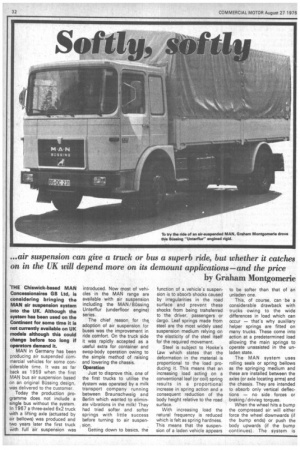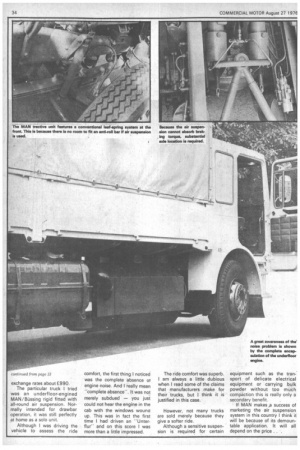...air suspension can give a truck or bus a superb
Page 34

Page 35

Page 36

If you've noticed an error in this article please click here to report it so we can fix it.
ride, but whether it catches on in the UK will depend more on its demount applications—and the price by Graham Montgomerie
THE Chiswick-based MAN Concessionaires GB Ltd, is considering bringing the MAN air suspension system into the UK. Although the system has been used on the Continent for some time it is not currently available on UK models although this could change before too long if operators demand it.
MAN in Germany has been producing air suspended cornmercial vehicles for some considerable time. It was as far back as 1959 when the first MAN bus air suspension based on an original Bussing design, was delivered to the customer.
Today the production programme does not include a single bus without the system. In 1967 a three-axled 6x2 truck with a lifting axle (actuated by air bellows) was produced and two years .later the first truck -With full air suspension was
introduced. Now most of vehicles in the MAN range are available with air suspension including the MAN / Kissing Unterflur (underfloor engine) series.
The chief reason. for the adoption of air suspension for buses was the improvement in ride comfort. On the truck side it was rapidly accepted as a useful extra for container and swop-body operation owing to the simple method of raising and lowering the chassis.
Operation Just to disprove this, one of the first trucks to utilise the ststem was operated by a milk transport company running between Braunschweig and Berlin which wanted to eliminate vibrations in the milk! They had tried softer and softer springs with little success before turning to air suspension.
Getting down to basics, the function of a vehicle's suspension is to absorb shocks caused by irregularities in the road surface and prevent these shocks from being trahsferred to the driver, passengers or Cargo. Leaf springs made from steel are the most widely used suspension medium relying on the elasticity of the steel itself for the required movement.
Steel is subject to Hooke's Law which states that the deformation in the material is proportional to the load producing it. This means that an increasing load acting on a conventional leaf (or coil) spring results in a proportional increase in spring action and a consequent reduction of the body height relative to the road surface.
With increasing load the natural frequency is reduced which is felt as spring hardness. This means that the suspension of a laden vehicle appears to be softer than that of an unladen one.
This, of course, can be a considerable drawback with trucks owing to the wide differences in load which can occur — that's why auxiliary helper springs are fitted on many trucks. These come into action at a predetermined load allowing the main springs to operate unassisted in the unladen state.
The MAN system uses rolling seals or spring bellows as the springing medium and these are installed between the axles (or axle locating arms) and the chassis. They are intended to absorb only vertical deflections — no side forces or braking/driving torques.
When the wheel hits a bump the compressed air will either force the wheel downwards (if the bump ends) or push the body upwards (if the bump continues). The system is claimed to be practically wear free with the absorption of vibrations being affected by separate hydraulic devices.
That deals with the deflection due to a bump function of the air suspension system. Now, how does it cope with variations in loading?
The spring chamber is connected to the normal air system of the vehicle through a level control valve which is mounted on the frame with its control lever connected to the axle or axle locating arm via a linkage.
When the body is depressed by a load, this control lever is moved owing to the relative movement between axle and body. This opens the air inlet to the chamber until the body/ axle relationship is restored. This distance can be preset at the linkage.
In principle, of course, there is a great similarity between this control system and the braking load sensing valve. When the load is removed, the reverse happens and air is released from the chamber.
The control valve does not respond to deflections of short duration. In other words it isn't constantly resetting itself because of normal suspension movement.
The quantity of air used in an air suspension system is not constant — it is proportional to the load. As a result, a nearly constant natural frequency of the body is achieved.
The truck market originally used the system to operate a bogie lift on the 6x2 vehicles. The bus operators, however, were more impressed by the fact that a constant step height could be maintained regardless of the number of passengers on board. The buses also use air suspension at the front.
Demountable
The chassis height variation facility offered by the MAN system should make it ideal for demountable operation. For this application on rigids, air suspension is fitted to all axles. For dropping the body, full air pressure is routed to the bellows, by-passing the level control valve which raises the body about 10cm (4in). The legs can then be lowered and the locks released.
• Discharging air from all the bellows simultaneously lowers the chassis which can then be driven out from under the body, MAN claims that a complete swop takes about five minutes with fully laden bodies.
Tractive units can be fitted' with air suspension but only on the rear axle. The reason for this is that, with an air system, an anti-roll bar is necessary, and on an air suspended tractive unit there's no room for one at the front.
In the opinion of the MAN engineers you shouldn't use an air-suspended trailer with a conventional leaf-spring tractor because of the difference in suspension frequency This does not apply to a drawbar outfit where the rigid and trailer are considered as two entirely separate units. The maximum weight limitation for the system is about 44 tonnes in artic or drawbar form.
The air suspension system is heavier than the conventional type — about 50kg (1 cwt) heavier for a four-wheel rigid. This is because of the extras
needed (eg radius rods) not because of a weight penalty of the air suspension itself.
It is also more expensive, but by how much MAN (GB) Ltd is not saying at the moment. When I was in Germany recently to try out an airsuspension MAN, the price penalty was about 4,500 Om in Germany — at current exchange rates about £990.
The particular truck I tried was an underfloor-engined MAN/Bussing rigid fitted with all-round air suspension. Normally intended for drawbar operation, it was still perfectly at home as a solo unit.
Although I was driving the vehicle to assess the ride comfort, the first thing I noticed was the complete absence ot engine noise. And I really mean "complete absence". It was not merely subdued — you just could not hear the engine in the cab with the windows wounu up. This was in tact the first time I had driven an "Unterflur" and on this score I was more than a little impressed. The ride comfort was superb. I am always a little dubious when I read some of the claims that manufacturers make for their trucks, but I think it is justified in this case.
However, not many trucks are sold merely because they give a softer ride.
Although a sensitive suspension is required for certain equipment such as the Iran: sport of delicate electrical equipment or carrying bulk powder without too much compaction this is really only a secondary benefit.
If MAN makes _a success of marketing the air suspension system in this country I think it will be because of its demountable application. It will all depend on the price .




















































































